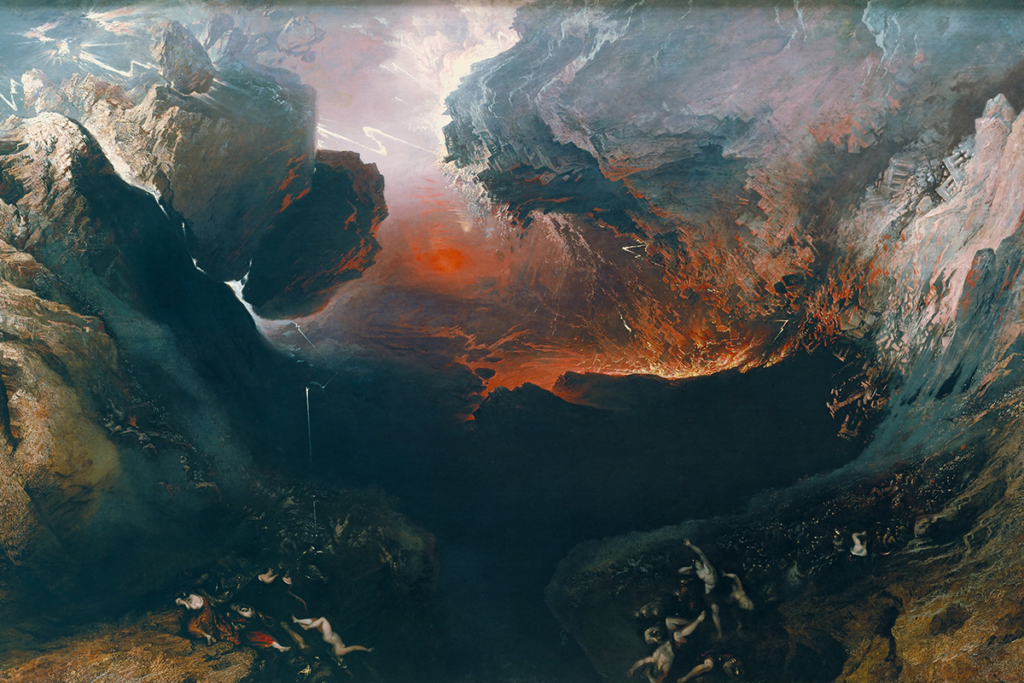A comparison between art and music

I chose Verdi’s Dies Irae and Martin’s The Great Day of His Wrath for this comparative essay. I shall focus on only two movements of the Requiem: Dies Irae and Tuba Mirum, which are both at the very beginning of the sequence. This Mass was composed in memory of Alessandro Manzoni, and its first performance was on the anniversary of his death in 1874.
When I first heard this musical composition I was struck by its drama. Especially at the beginning of Dies Irae, I felt like the whole world was falling on me through the music. All the various musical instruments together give a dramatic sensation that produces aa sense of awe before the omnipotence of God’s judgement. Listening to the drums and trumpets, especially at the beginning of the Dies Irae and before the Tuba Mirum, I can only admire the glory of God’s second coming and recognize the passing character of my earthly life.
Despite the drama of Verdi’s work, far from producing despair, this music invites hope. There have been many debates about the text of the Dies Irae in recent years, but according to Benedict XVI’s encyclical Spe Salvi, the Last Judgment is an occasion to exercise hope: “The image of the Last Judgement is not primarily an image of terror, but an image of hope; for us it may even be the decisive image of hope”[1]. He affirms that the God who comes to judge has willingly given his life to save us. It is the day of wrath, but this is not wrath against the human person but against sin that wants to destroy God’s most beloved creatures. His judgment is my authentic liberation from evil that stalks me in this life. This hope does not lead me to fall into the sin of presumption but challenges me to lovingly assume responsibility before the Lord. For Pope Benedict XVI, the image of the Last Judgement “is an image that evokes responsibility, an image, therefore, of that fear of which Saint Hilary spoke when he said that all our fear has its place in love God is justice and creates justice. This is our consolation and our hope”[2].
Verdi distinguished himself through his operas, and his operatic style is present throughout the Requiem. I cannot ignore the debate as to whether a musical composition like this is suitable for liturgy. I must admit that some movements seem too theatrical in style for a church setting. Nevertheless, I think that some of the movements, if alternated with Gregorian chant, could be part of the liturgy, as the effect that Verdi’s music has on the soul is undeniable. In addition, contemplation through music is also a way of actively participating in the liturgy.[3]
I want to compare this musical work with The Great Day of His Wrath, an 1851–1853 painting by John Martin. It is part of a triptych entitled The Last Judgement. The artwork deals with the same theme as Verdi’s musical composition. Drama and religious sentiment are also present in the painting. This triptych on the final judgment differs from others of previous centuries: Christ and his saints do not appear, but the event is reflected through nature, reflecting the spirituality of his time and Romanticism.
When I contemplate the painting, the same feelings arise in my soul as when I listen to the Dies Irae: there is admiration before the omnipotence of God who comes to judge. Moreover, now the expected day has arrived; the heavens open, and the whole of creation reacts to the triumph of Christ. Watching the city fall with its grand buildings reminds me that my only security must be in Christ, who remains forever. I see the drama of the people on either side of the canvas wailing or trying to flee in vain. However, I shall focus attention on one of the figures who is standing in the darkness near the center of the canvas. This figure raises his hands toward the ray of light that seems to come from God. During the commotion, this person does not express despair but seems to raise his arms in hope, knowing that his deliverance, the triumph of his Lord, has come. This must be the attitude of the faithful before the Final Judgment: trust in the Lord.
Through the drama of both works, Verdi’s music and Martin’s painting, the relation hope – fear of God is presented. Both works remind us that this life is not forever. They invite us to prepare ourselves responsibly for judgment so that we can live with hope that the day of wrath will be the day of our liberation; the day of joining the triumph of the R
[1] BENEDICT XVI, Spe Salvi, no. 44.
[2] Ibid.
[3] Cf. J. RATZINGER, The Spirit of the Liturgy, Ignatius Press, San Francisco 2000.




